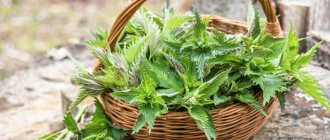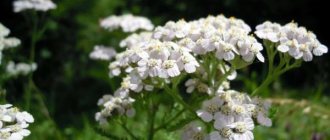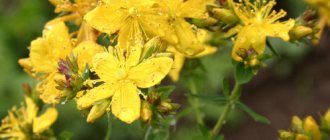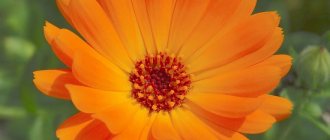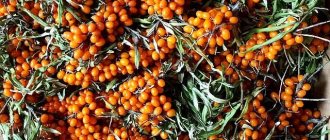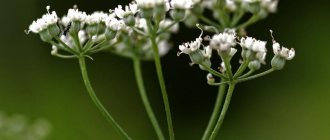Usage: Dill seeds and essential oil are used in medical practice. Dill fruits are harvested in the fall, when the plant and seeds turn brown.
Related article Herbs against headaches: three recipes based on St. John's wort and dill The seeds are dried and stored in a cool, dry place.
Beneficial properties: the fruits and essential oil of dill relieve spasms, lower blood pressure, have an expectorant, carminative, sedative, wound-healing, diuretic and antihemorrhoidal effect.
The fruits are used to improve appetite and for insomnia.
Dill is useful for obesity, diabetes, salt deposition, for stimulating milk secretion in nursing women, for allergic skin itching and pustular diseases of the facial skin.
Contraindications: dill preparations are contraindicated during pregnancy.
Recipe
1 tbsp. l. herbs or seeds, brew 1.5 cups of boiling water, leave for an hour and take 1-2 tbsp. l. 4-5 times a day to lower blood pressure.
Characteristics of greenery
Dill is an annual herbaceous plant. When you get acquainted with it, you will clearly notice a strong characteristic odor. The leaves of the plant are used to prepare dishes and give them unusual freshness. The fruits of dill are used for gastrointestinal diseases to obtain a carminative and antispasmodic effect.
The plant belongs to the Umbelliferae family. It is found both in the garden and in the wild. Dill is unpretentious; any soil will become a home for it. Even low temperatures (about -5 °C) are not a problem for the plant.
Dill is characterized by the following external signs:
- the height of the erect stem is 50–120 cm;
- there is only one shoot, but it is distinguished by its branching;
- the leaves that housewives use in the kitchen are divided into thread-like “needles”;
- the top of the rounded stem is crowned with yellow umbrella inflorescences;
- elliptical dvosemyanka is a peculiar fruit.
Even in ancient times, healers noted the positive properties of the plant. The fruits of dill are used in official medicine, and the remaining parts are used in folk medicine.
History of origin and geography of dill
Aromatic dill is a traditional plant that has been cultivated in every garden in Russia since ancient times and is actively used today.
The homeland of this herb is Asia and India. Dill was first used by Egyptian doctors more than 5 thousand years ago. Ancient Egyptian inscriptions mention it as a multifunctional plant. The ancient Greeks were sure that such a culture was a remedy that relieved headaches. To make such a decoction, greens and coriander were enough.
Cuisine of Ancient Egypt. Growing dill
In the 3rd millennium BC. The cultivation of this crop began in Sumer. Then it spread to Assyria and Babylon. Currently in great demand. Gradually spread throughout Europe and eventually penetrated into Russia. Now it is widely used.
Wild dill is found in Egypt, Iran, Asia, and India. As a garden plant, it is distributed on all continents. It blooms near residential buildings, in garden beds, and along roadsides.
Compound
The plant is rich in beneficial microelements:
- Vitamins. The leaves contain vitamins C, PP, P, E, a group of vitamins B. The plant itself contains a powerful antioxidant - provitamin A.
- Minerals. The seeds are famous for their large amounts of potassium and manganese, copper and zinc, calcium and sodium. The stem contains iron, molybdenum and phosphorus.
- Essential oil. It is this that gives the plant its characteristic smell. D-carvone was found in the oil. According to some studies, this substance is the main component for the prevention of cancer.
- Active components. The leaves contain chlorophyll, lutein, violexanthin. Flavonoids were found in the stem and flowers, which can speed up metabolism and improve metabolism.
- Nitrogen compounds. They help activate digestive functions.
As a result
Effective medications very often turn out to be a familiar herb that has fewer side effects compared to tablets and injections. They are also good for preventing existing diseases. It is recommended to consult with your doctor before use.
This article is for informational purposes only, please consult your doctor for details!
Useful properties of the plant
Why are dill fruits so valued in medicine? The beneficial properties of this plant are pronounced, so it saturates the body with microelements and replenishes vitamin deficiencies. Doctors are of the opinion that dill should be consumed year-round. Young mothers fearlessly give their newborn babies seed-based water to relieve colic.
Dill seeds are beneficial for the body in the following cases:
- to dilate blood vessels and strengthen their walls;
- to cleanse the body of toxins;
- with inflammation of the gums;
- to get rid of spasms and cramps of the limbs;
- to eliminate inflammatory processes;
- to improve appetite and food digestion;
- to strengthen the immune system;
- as a diuretic;
- to stimulate the excretion of bile;
- as a bowel relaxant;
- to remove mucus from the respiratory tract;
- to avoid flatulence.
If it is not possible to collect dill seeds from the garden, you can purchase them at the pharmacy.
For women, dill seeds are especially useful:
- help normalize the menstrual cycle;
- reduce the severity of symptoms of premenstrual phenomena;
- maintain calcium levels in the body during menopause;
- help avoid the development of osteoporosis.
Men can also benefit from consuming the plant. Thanks to the dilation of blood vessels, dill is able to provide a high-quality and long-lasting erection.
First aid for illnesses
Nutritionists recommend consuming dill seeds for people suffering from excess weight. They are able to normalize the proper functioning of internal organs. In addition, the fruits are useful for:
- metabolic disorders, insomnia, chronic fatigue;
- decreased immunity;
- obesity;
- diseases of the urinary system;
- hemorrhoids;
- ailments of the cardiovascular system;
- conjunctivitis;
- respiratory tract diseases;
- hypertension;
- diseases and inflammations of the gastrointestinal tract;
- helminthiasis;
- prostatitis;
- diabetes
Pregnant women (I and II trimesters) and nursing mothers also use the fruits of fragrant dill. The use of the plant allows you to improve the functioning of the intestines and biliary system. It is useful to use them when breastfeeding, since beneficial substances from the mother's milk reach the baby.
Is there vitamin K and what else does it contain?
Dill contains a sufficient amount of vitamins, which allows us to regard the greens not only as a culinary seasoning, but also as a medicinal plant:
| Vitamin | Weight, mg | Impact on the body |
| Beta carotene | 4,5 |
|
| B1 (thiamine) | 0,03 | A necessary element for muscle fibers and nerve cells. |
| B2 (riboflavin) | 0,1 |
|
| B5 (pantothenic acid) | 0,3 |
|
| B6 (pyridoxine) | 0,2 | Ensures normal functioning of the heart muscle. |
| AT 9 | 27 mcg |
|
| WITH | 100 |
|
| E | 1,7 |
|
| K (phylloquinone) | 62.8 µg |
|
| PP (nicotinic acid) | 14 |
|
Dill is especially rich:
- ascorbic acid (100 g of product contains 131% of the daily requirement of this substance);
- beta-carotene (112%, respectively);
- vitamin K (52.3%).
Contraindications
If you use dill fruits excessively, contraindications will not take long to appear. They were known back in the time of Avicenna. An overdose of dill-based medications leads to:
- hypotension (excessive decrease in blood pressure);
- sudden loss of strength;
- fainting or pre-syncope;
- temporary visual impairment.
People suffering from hypotension and pregnant women in the last trimester abstain from dill therapy.
Help with swelling
The properties of fragrant dill are used for a diuretic effect. The fruits are used as a base for infusion. To eliminate swelling, patients consume 0.5 cups of the prepared product 2-3 times a day. If it is necessary to achieve a carminative, expectorant or sedative effect, the infusion is used 15 minutes before meals, 1 tablespoon. For these diseases, the drug is taken 3–5 times a day.
To prepare the infusion, you need to measure 1 tablespoon of dill seeds and 200 ml of water. The fruits of the plant are crushed with a coffee grinder or another method. The prepared raw materials are poured with boiling water. The container is covered with cotton or linen cloth. The product is filtered 15–20 minutes after infusion.
Fresh herbs also help with swelling. To do this, chop it finely and immediately eat 1 teaspoon. Dill is washed down with 1/3 glass of water. 2-3 meals of fresh greens can also help get rid of swelling.
Boiled
Heat treatment changes both the structural and mechanical properties of greens and the chemical composition. The cell walls of plants consist of substances that are not digested in the human stomach - these are fiber and pectin substances.
When cooked, tissues and cell walls are destroyed, lose elasticity, the connection between cells is disrupted - the culture becomes soft and loose.
During heat treatment, polysaccharides and structural proteins are partially dissolved, and protopectin is broken down. The concentration of vitamins is reduced by 23-60% - depending on the cooking time and degree of heating.
For example, the hydroxyproline content in raw dill is 20.3 mg per 100 g, and in boiled dill only 12.3 mg .
Boiled dill is not as healthy as fresh dill, but it is digested and absorbed better. And the calorie content of greens is reduced due to swelling with water.
Infusion for flatulence
Dill fruits are an excellent remedy for bloating and constipation. A decoction is made from the seeds and taken warm. The product is consumed 30 minutes before meals, 0.5 cups.
To prepare the decoction you will need:
- plant seeds - 1 tablespoon;
- water (preferably milk) – 1 glass.
To prepare the decoction, pour dill seeds into boiling liquid and simmer in a steam bath for 10 minutes. After which the product is filtered and cooled to a comfortable temperature.
Dill root system
The root of this spice is thin, taprooted, and multi-branched. After germination, the formation of the dill root system begins, which ensures rapid growth. This happens in the first week. The growth of green mass is not so important at this stage.
After the formation of the primary root system, the development of the vegetative part of the plant begins. Essential and fatty oils prevent annual seeds from germinating. They have a preservative effect, so it can sprout in the ground for up to two weeks.
Dill roots
Greens grow well near many vegetable crops: lettuce, beans, onions. But it doesn’t get along with some vegetables at all. For example, with tomatoes. It is an excellent neighbor for many vegetables, as it gives them a pleasant aroma.
Parasite therapy
To get rid of helminths, you need to take grass seeds in the required proportion (1 teaspoon) in dry form for 3-4 days. For this you will need:
- dill fruits – 1.5 teaspoons;
- cumin seeds – 1.5 teaspoon.
The raw materials are thoroughly mixed and become suitable for use. To use dill fruits, the beneficial properties and contraindications of which are discussed above, you must follow the instructions, otherwise you can harm the body.
Help with constipation
For such a delicate problem, dill oil is used. It is not necessary to buy the drug at the pharmacy, since it is easy to prepare. Although doctors recommend purchasing the medicine from pharmacists. The basis of the drug is the fruits of dill. We will consider instructions for using such a tool below. When treating constipation you will need:
- purified water – 0.5 cups;
- dill oil – 10 drops;
- honey – 0.5 teaspoon.
The ingredients are mixed and the solution is applied 3 times a day, 0.5 cups. In 1–2 days, the stool returns to normal. In addition to the problem of constipation, this remedy relieves colic and bloating.
Dried
Let's consider what happens when the grass is dried, whether useful substances remain, how many kcal will be per 100 g of product. Drying greens also preserves the chemical composition of the spice, but only if it was carried out according to the rules and without strong heating. The beneficial substances and aroma of dried dill are preserved, but the calorie content of the greens increases due to the evaporation of water - it is 78 kcal per 100 grams of culture.
Dill is truly a miracle cure. It is widely used in cosmetology, aromatherapy and medicine. The plant is an excellent diuretic, as well as an assistant in the fight against excess weight, cystitis, kidney and pancreas diseases. Dill can be used by both men and women, as well as small children.
Therapy for hypertension
Hypertensive patients are happy to use a decoction based on the fruits of dill. The instructions are to use the following ingredients:
- fruits - 3 tablespoons;
- boiling water – 1 cup;
- water - if necessary.
Dill is crushed and poured with boiling water. The broth is simmered in a water bath or low heat for 15 minutes, after which it is infused for 45 minutes. The drink is filtered and cold purified water is added to it to the original volume.
When using a folk remedy, you need to take into account the possible interaction of pharmaceuticals and dill infusion. Their tandem leads to a sharp decrease in pressure.
The amount of decoction used depends on the severity of hypertension. The specialist prescribes 1/3 or 0.5 glasses of the drink three times a day for 3 weeks (21 days).
Help with weight loss
There are 2 options for preparing a miraculous infusion: from seeds and herbs.
First way. You will need:
- seeds - 2 tablespoons;
- boiling water – 1 cup.
The fruits are poured with hot water and infused in a thermos for half an hour. The prepared product is divided into 3 parts and drunk throughout the day.
Second way. You will need:
- fresh dill - 1 small bunch;
- medium cucumber – 1 pc.;
- low-fat kefir – 1 glass.
It is necessary to finely chop the greens and cut the cucumber into small squares. The cocktail is prepared in a blender, into which kefir and ingredients are poured.
The prepared product replaces dinner. You need to take this cocktail for 2-3 weeks.
To normalize the menstrual cycle
For scanty discharge during menstruation, take tea made from dill leaves.
You will need:
- dill juice – 1 part;
- honey – 1 part.
The greens are passed through a meat grinder, then the mixture is squeezed out and the juice is drained. Honey is added to it. The prepared drug is taken 1 tablespoon three times a day.
For heavy discharge during menstruation and uterine bleeding, take tea from the flowering umbrellas of the plant.
You will need:
- dill baskets with seeds - 1 tablespoon;
- boiling water – 1 cup.
Pour water into the prepared raw material in a thermos and let it brew for 20 minutes. Take the infusion 1 glass three times a day until the bleeding stops.

